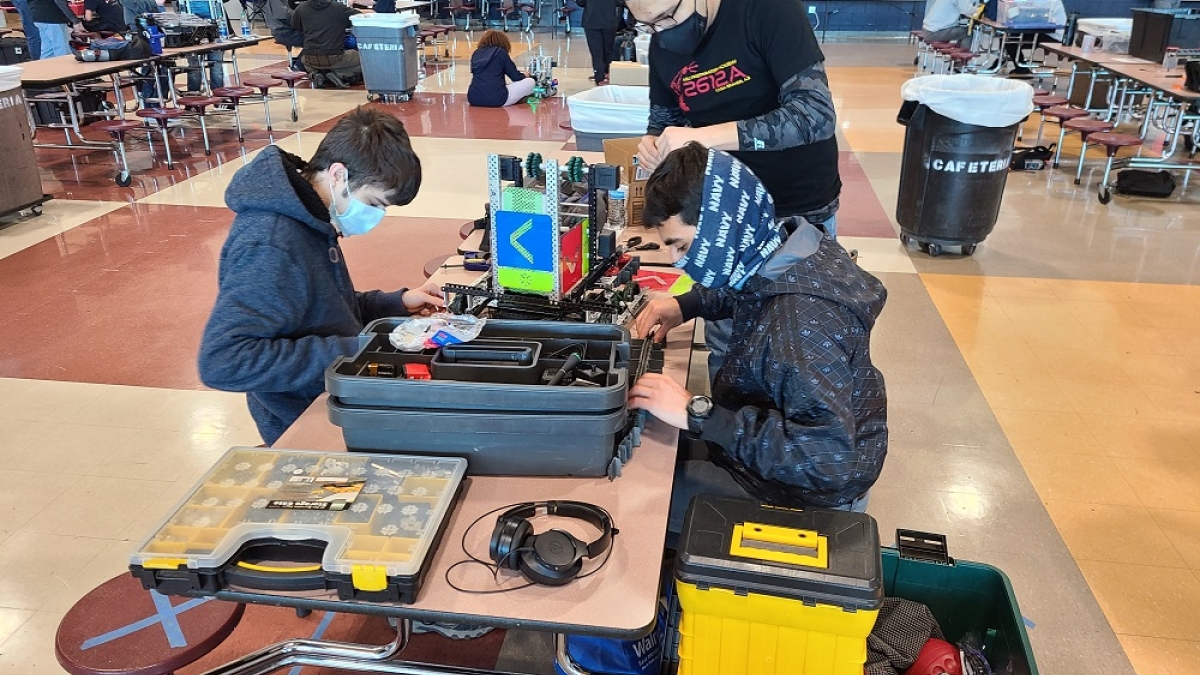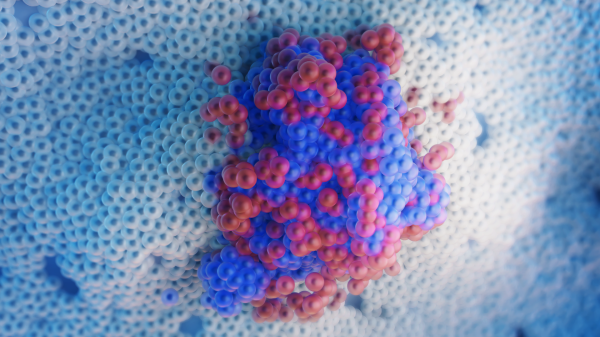ASU Prep Casa Grande high schoolers bring 'Chaos' to robotics world championships

(From left) Carlos Servantes, team vice president, Rivaldo Contreras (standing), treasurer, and David Reyes, team captain, work on their robot.
The robotics underdogs from Casa Grande are on a winning streak.
The student engineers of ASU Preparatory Academy in Casa Grande made their own luck in a tumultuous year for students, qualifying for the Vex Robotics World Championships in 2021. The team, Chaos Theory, earned their spot among the 260 other groups competing virtually by winning the state championship against 32 other Arizona teams on April 10.
Though they don’t have the financial resources of other teams, Chaos Theory has earned tremendous success since launching in 2016. This year is the third time they’ve qualified for the world competition (the first time in 2018 and then in 2020, the latter of which was canceled due to COVID-19). Starting on May 20, they competed in the first all-virtual Vex World Championship.
Captain David Reyes and secretary/treasurer Rivaldo Contreras, both graduating this month, started on the team in their first year of high school and competed at the in-person 2018 world competition. Reyes said each year is an exercise in engineering, programming and game strategy.
“This year, our robot is basically the ideal design that you would want for this game,” Reyes said. “We worked together as a team. And we just observed other teams from afar and saw what their shortcomings were. And then we applied those to our robot.”
This year’s challenge was to build a robot that could move around a 12-by-12-foot field, grab the correct color balls and throw those balls into the correct hoop. The robot itself is sort of roller-skate-shaped: four wheels, four motors, two rollers and lots of rubber bands to collect and eject balls, either into your hoop (for you to score) or behind the robot (to divert opponents’ balls). Every year, the challenge and the fun is about building, testing and modifying the robot for the year’s specific game. But this wasn’t a typical year.
Though the team usually spends much of the fall designing and building their robot, COVID-19 limited their meeting time until in-person learning resumed. In the meantime, fewer people at school meant that the team could construct a game course on top of lab tables to practice on.
“It was really hard to practice; we had like limited timing ... we would only have a certain amount of time, only to build the robot and not have enough time to practice,” Contreras said. “And so when we got to the competition, we didn't have that practice we needed to be able to succeed throughout the match.”
Yet when two teams competed against each other for two-minute rounds at the state competition in April, the Casa Grande students came out on top. Sean Mark, the team’s founding coach and science teacher at ASU Prep Casa Grande, said the students were adjusting to the different practice and tournament styles. Though the state championship was modified, it was still in person. The remote world competition was the first and perhaps only time the games will be virtual.
“We have some modifications that we made to our game strategy based on the new remote nature of the game,” Mark said.
Trial and error is one of the most important lessons in robotics. All year, students worked together to build and program their robot, which they dubbed Choasu (a mashup of their team name and ASU). They documented their progress, mistakes and experiments in a notebook to explain what their thinking was behind every design choice and modification. Students got to work with and meet fellow engineers from all over the state and the world, making team alliances and getting leadership experience in fundraising and acquiring specialized materials.
Building the robot is one thing, but making it do what you want it to do is an entirely separate endeavor. Senior Carlos Servantes, the vice president for the team, programmed the robot in C++ to give Choasu instructions for what to do and how to win.
“The programmer obviously makes a robot move. If Carlos wasn't here, this robot would just stay here; it wouldn't do anything,” Reyes said.
Servantes describes it as simply telling the robot’s brain what to do and automating as much as possible to make it easy for the driver.
“You want to get it as user-friendly as possible, so that you don't have to concentrate too hard on what you're doing,” Servantes said. “You just put in a few lines (of code) that you tell it whether you want it to coast, when it brakes or to hold its position. … You have basically a nice little paragraph for the drive train, give it the parameters you want and tune your driving as much as you want.”
Servantes started getting involved consistently with Chaos Theory his junior year. Robotics allowed him to gain some hands-on learning that meshes well with his interests.
“I'm a technology-oriented person. I've used computers since I was 4 years old. ... So I'm already into that sort of thing on the programming side of things, although I also like doing stuff with my hands,” he said. “The first and the second year, I was in and out because of my grades. I really struggle with my grades, because I have ADHD. I was always on the edge.”
Being involved in the team gave Servantes an outlet to keep pursuing his engineering interests and also motivated him to keep his GPA up so he and his friends could keep competing.
“That's when I really tried my best to keep my grades up,” he said. “I was able to attend and I was able to go to the competitions. Everything was super, super fun. And robotics is a thing that's like that. It's really cool because it interests me as a subject, and it's also really fun to go and compete with other people and to learn about other designs and things like that,” he said.
Servantes wants to pursue IT or a cyber field in college, and Mark said that’s not atypical: More than 50 percent of the team’s alumni have gone into a science, technology, engineering or math field. Students don’t necessarily have previous experience in robotics when they join, and the feedback from participants’ families is that parents are thrilled to see their kids grow and come out of their shells while gaining unique skills.
“Having robotics is important for the enrichment of students at this school. It gives them hands-on STEM experience that they would not get elsewhere in Casa Grande, and it teaches them teamwork, attention to detail, project management and engineering skills that they can take with them wherever they go next,” Mark said.
Part of what has made the team a Cinderella story has been resources. But they have earned crucial assistance from local sources. The team was able to upgrade their system thanks to a grant from the Diamondbacks Foundation as well as a gift from the ASU Vex team, which donated their robot to Chaos Theory when the high schoolers qualified for the world competition. Using the college team’s building materials and the grant funding was invaluable in evening the playing field.
“Despite having financial difficulties, we made do with what we have,” Reyes said. “Even if things go wrong or things don't go as we wanted to go, (we say) let's move on with how can we use this to the best of our advantage? And how can we make it work without necessarily having the things in place to make it work?”
Julie Young, vice president of ASU Educational Outreach and Student Services and managing director of ASU Prep, said that the team’s persistence and success in the state competition — especially in a time of learning disruption — is an inspiring accomplishment.
“Congratulations to these amazing students. The ASU Prep Casa Grande team has created quite the legacy,” she said. “This is so exciting, and we are incredibly proud of all of you.”
Mark said the team learned new strategies at the world competition and enjoyed working with and competing with teams from all over the world. Three hundred teams from around the world were invited to participate; 260 teams actually competed. Teams in Chaos Theory’s division included students from Ireland, South Korea and Australia.
The team leaders will be off to college soon, with Servantes planning to study IT at Grand Canyon University, Reyes planning to pursue business at GCU and Contreras planning to pursue theology in Oregon. Cervantes and Reyes are thinking about participating in Vex in college. Regardless, they’ll carry the connections, skills and confidence of their robotics experience with them forever.
“Being part of a club that demands maturity has shaped me to be a better person,” Servantes said. “School life for me is particularly difficult because I have ADHD; subsequently I always take longer than I should to finish work, and I always have something that I'm behind on. Robotics was an escape for me to do something interesting, as well as an opportunity to get the ever-crucial social interaction we all need. I will forever look back upon my days in robotics as my happiest times during high school.”
Team leaders
David Reyes, captain/president
Carlos Servantes, vice president
Rivaldo Contreras, secretary/treasurer
Team members
Kayden Glickman-Williams
Bruno Acosta Perez
Andrew De Lapp
Nicholas De Lapp
Job Hernandres
Tony Garcia
To support the ASU Prep CG robotics team, follow these steps to donate:
1. Click here and select “Casa Grande High School.”
2. Add in the memo: ASU Prep CG Robotics Team.
More Science and technology

Lucy's lasting legacy: Donald Johanson reflects on the discovery of a lifetime
Fifty years ago, in the dusty hills of Hadar, Ethiopia, a young paleoanthropologist, Donald Johanson, discovered what would…

ASU and Deca Technologies selected to lead $100M SHIELD USA project to strengthen U.S. semiconductor packaging capabilities
The National Institute of Standards and Technology — part of the U.S. Department of Commerce — announced today that it plans to…

From food crops to cancer clinics: Lessons in extermination resistance
Just as crop-devouring insects evolve to resist pesticides, cancer cells can increase their lethality by developing resistance to…